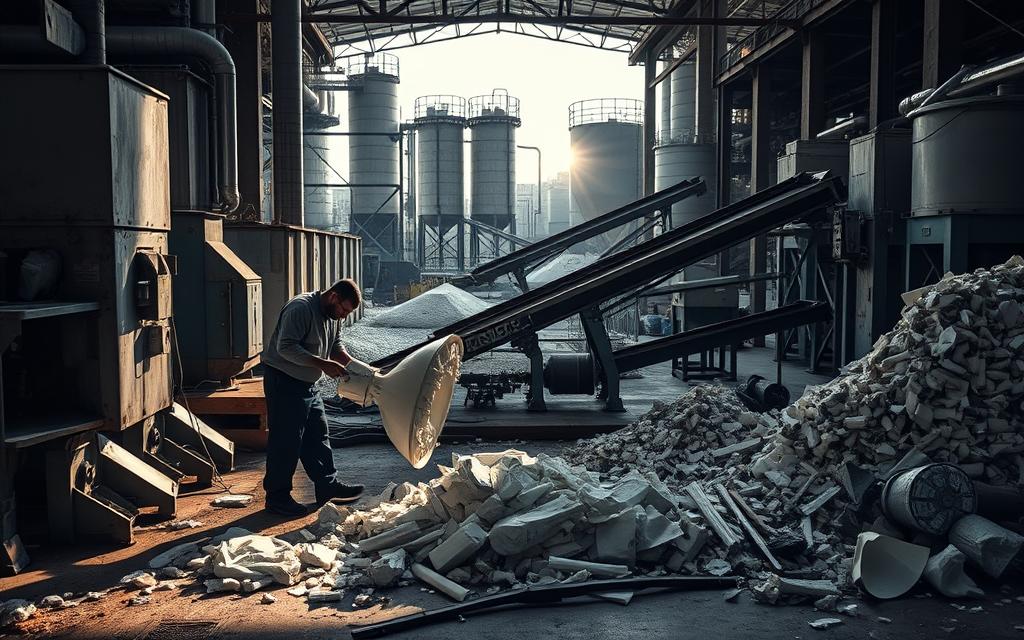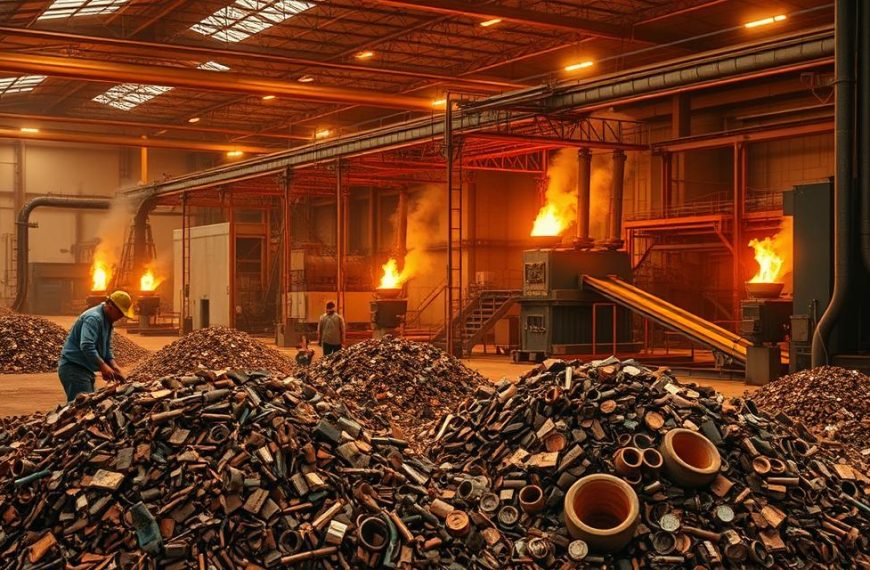Fibreglass, a versatile material, is widely used in various industries due to its strength and durability. However, its growing use has led to significant waste challenges. Wind turbine blades, often over 350 feet long, and aerospace components are major contributors to this issue.
Wind turbine blades, with a lifespan of about 20 years, face wear from tip speeds exceeding 150 mph. Similarly, the aerospace sector generates substantial amounts of composite waste. By 2050, these industries are projected to produce hundreds of thousands of tons of discarded materials.
Despite these challenges, there are effective recycling methods available. Mechanical, thermal, and chemical processes offer solutions to manage this waste. For example, Germany’s cement kiln method processes 15,000 tons of composite materials annually. Yet, reliance on landfills remains prevalent, highlighting the need for broader adoption of these technologies.
What is Fibreglass and Why is Recycling Important?
Known for its durability, fibreglass is a blend of glass fibers and plastic resins. This composite material, also called glass-fiber-reinforced plastic (FRP), is widely used in industries for its lightweight and robust properties. Its versatility makes it ideal for applications ranging from insulation to aerospace components.
There are several types of fibreglass, each with unique properties. A-glass is alkali-resistant, C-glass is chemical-resistant, and E-glass serves as an excellent electrical insulator. These variations cater to specific industrial needs, ensuring the material’s widespread use.
Despite its benefits, fibreglass poses significant environmental challenges. The resin used in its production is non-biodegradable, and the fibers persist in ecosystems. For example, Hurricanes Harvey and Irma destroyed over 63,000 boats, creating $655 million in waste. Similarly, the EU estimates that 14,000 wind turbine blades will require disposal by 2025.
Landfills are not a sustainable solution for fibreglass waste. Initiatives like France’s APER program, which has recycled over 8,000 boats since 2005, and Rhode Island’s cement filler pilot program highlight the importance of innovative recycling methods. Addressing these challenges is crucial for protecting the environment and conserving resources.
Can Fibreglass Be Recycled? Exploring the Possibilities
Recycling fibreglass presents unique challenges due to its composite nature. The inseparable bond between glass fibers and resin makes it difficult to process. Unlike steel, which is straightforward to recycle, fibreglass requires hybrid methods to break down its components.
Why Fibreglass Recycling is Complex
The composite material structure of fibreglass complicates recycling. Mechanical processes often shorten the fibers, reducing their strength. Chemical methods dissolve the resin but rely on hazardous solvents. These challenges highlight the need for advanced recycling technologies.
Pyrolysis is one effective process. It involves heating the material to 500°C in an oxygen-free environment. This method recovers 25% of the material as pyrogas and pyro-oil. The gas serves as a clean-burning substitute for natural gas, while the oil resembles heavy crude.
Industrial-scale recycling is also making strides. Germany’s Zagons Logistik uses diamond cable saws to cut wind turbine blades into 35-40 ft sections. Their facility processes 400-500 tons of material monthly. Mobile containerized plants, like those from Isodan, enable on-site recycling, further improving efficiency.
| Method | Output | Efficiency |
|---|---|---|
| Pyrolysis | Pyrogas, Pyro-oil | 25% recovery |
| Mechanical | Shortened fibers | Reduced strength |
| Chemical | Dissolved resin | Requires solvents |
Despite these advancements, recycling fibreglass remains a multi-stage challenge. Innovations in process technology and industrial applications are essential to address this growing waste issue effectively.
Step-by-Step Guide to Fibreglass Recycling
Effective fibreglass recycling involves multiple steps and advanced techniques. Each process—mechanical, thermal, and chemical—offers unique solutions to manage this durable material. Understanding these methods is essential for reducing waste and promoting sustainability.
Mechanical Recycling of Fibreglass
Mechanical recycling transforms fibreglass into reusable pieces. This process involves shredding the material into smaller fragments. American Fiber Green Products uses this method to create filler for decking and benches.
Wolfgang Unger’s 1973 fiber-harvesting technique is another example. It grinds fibreglass into powder for low-grade composites. While this method reduces material strength, it remains a practical solution for certain applications.
Thermal Recycling of Fibreglass
Thermal recycling uses heat to break down fibreglass. Cement kilns in Germany process 15,000 tons annually, using the material as fuel. This process not only reduces waste but also supports energy-efficient cement production.
Pyrolysis is another thermal method. It heats fibreglass to 500°C in an oxygen-free environment, producing gas and oil. The recovered gas serves as a clean energy source, making this process self-sufficient.
Chemical Recycling of Fibreglass
Chemical recycling dissolves the resin in fibreglass, recovering high-quality fibers. Washington State University has patented a solvent-based process that reduces costs and uses safer chemicals. This method is ideal for industries requiring pristine materials.
GE and Veolia’s partnership highlights the potential of chemical recycling. They shred wind turbine blades for use in concrete plants, showcasing innovative applications of this technology.
- Mechanical: Produces fillers for low-grade composites.
- Thermal: Generates energy and cement substitutes.
- Chemical: Recovers high-quality fibers for industrial use.
Industries Producing Fibreglass Waste
The growing use of fibreglass in key industries has led to significant waste challenges. Two sectors stand out as major contributors: wind energy and boat manufacturing. Both industries generate substantial amounts of waste, creating a pressing need for effective recycling solutions.
Wind Turbine Blades: A Major Source of Fibreglass Waste
Wind turbine blades are a significant source of fibreglass waste. These structures, often over 350 feet long, have a lifespan of 20-25 years. Tip speeds exceeding 150 mph cause leading-edge erosion, necessitating replacement.
By 2020, the EU Wind Energy Association reported 50,000 tons of blade waste annually. Companies like Vestas have pledged zero-waste goals by 2040. Innovative projects, such as Re-Wind’s blade bridges and roofs, showcase potential repurposing methods.
Boat Manufacturing and Fibreglass Disposal
Boat manufacturing also contributes heavily to fibreglass waste. Many hulls from the 1960s are now costly to dispose of. In 2017, hurricanes Harvey and Irma damaged 63,000 recreational boats, creating $655 million in cleanup costs.
Countries like France and Japan are leading efforts to reduce landfill use. France’s APER network operates 20 coastal sites, while Japan’s 414-dealer recycling network achieves an 88% non-landfill rate. Rhode Island’s pilot program shreds hulls for cement, further reducing waste.
| Industry | Waste Source | Recycling Initiatives |
|---|---|---|
| Wind Energy | Turbine Blades | Vestas’ zero-waste pledge, Re-Wind projects |
| Boat Manufacturing | Hulls | France’s APER network, Japan’s recycling network |
Both industries face unique challenges in managing fibreglass waste. While the automotive sector has made progress in recycling, the marine and wind energy sectors lag behind. Addressing these gaps is crucial for a sustainable future.
Innovations in Fibreglass Recycling
Innovative solutions are transforming how industries handle composite material waste. From civil engineering to global initiatives, these advancements are paving the way for a more sustainable future.
Repurposing Fibreglass in Civil Engineering
Decommissioned wind turbine blades are finding new life in civil engineering projects. The Re-Wind Project in Ireland and Northern Ireland repurposes these blades into pedestrian bridges, powerline towers, and affordable housing roofs. This approach not only reduces waste but also creates durable products for communities.
Plasti-Fab’s closed-loop production is another example. They use recycled fiberglass reinforced plastic (FRP) cores to manufacture new materials. This method minimizes waste and supports sustainable manufacturing practices.
Global Efforts to Improve Fibreglass Recycling
Global Fiberglass Solutions (GFS) is leading the charge with its patented recycling methods. In collaboration with Washington State University, GFS plans to open an 8-ton/hour processing facility in Texas. This facility will significantly enhance the capacity to recycle composite materials.
The EU’s 2020 report, “Accelerating Wind Turbine Blade Circularity,” highlights design and technical solutions for the wind turbine life cycle. Companies like Vestas aim to produce zero-waste turbines by 2040 through supply chain partnerships. Siemens Gamesa’s RecyclableBlade technology further supports offshore wind energy sustainability.
Isodan’s portable, dust-free production plants and Amour Fiber Core’s consumer products, such as picnic tables and seawalls, demonstrate the versatility of recycled materials. These efforts showcase the potential for innovation in tackling composite waste challenges.
For more details on emerging innovations in fiberglass recycling, explore the latest advancements in this field.
How to Dispose of Fibreglass Responsibly
Proper disposal of fibreglass ensures safety and environmental protection. This durable material requires careful handling to avoid health risks and minimize its impact on the environment. Whether you’re dealing with small household items or large industrial waste, following the right steps is essential.
Safety Precautions for Handling Fibreglass
Handling fibreglass demands strict adherence to safety protocols. OSHA guidelines mandate the use of equipment like N95 masks, gloves, and goggles to protect against airborne fibers. These precautions are crucial to prevent respiratory issues and skin irritation.
“Respirators, cut-resistant gloves, and eye protection are mandatory when handling fibreglass.”
Outdoor grinding is recommended to reduce the risk of airborne fibers. This method minimizes exposure and ensures safer disposal. Avoid DIY breakdowns, as 80% of injuries occur during improper handling.
Professional Fibreglass Disposal Services
For large-scale or hazardous fibreglass waste, professional services are the safest option. Companies like Ridly in Australia offer same-day removal with PPE-trained teams. Their certified waste tracking ensures compliance with environmental regulations.
Japan’s government-funded dismantling programs and France’s APER tax-funded initiatives are excellent examples of organized disposal systems. These programs highlight the importance of professional involvement in managing fibreglass waste.
| Service Provider | Key Features | Efficiency |
|---|---|---|
| Ridly | Same-day removal, certified tracking | High |
| Japan’s Dismantling Program | Government-funded, 88% non-landfill rate | Moderate |
| France’s APER Initiative | Tax-funded, coastal site network | High |
By relying on professional services, you can ensure safe and efficient disposal of fibreglass. These services not only protect your health but also contribute to a cleaner environment.
Conclusion: The Future of Fibreglass Recycling
The future of managing composite materials lies in innovative recycling solutions. Currently, 72% of FRP ends up in landfills due to high costs, but regulatory shifts are expected to drive change. Stricter landfill bans in the EU and US, mirroring Germany’s policies, will likely accelerate this transition.
Cement kiln co-processing, like Holcim’s successful 10-year integration in Europe, offers an immediate and scalable solution. This method not only reduces waste but also supports sustainable manufacturing practices. Industry collaboration, such as WindEurope-EuCIA partnerships, is essential to scale these efforts globally.
Companies like Vestas and Global Fiberglass Solutions (GFS) are leading the way. Vestas’ 2040 zero-waste roadmap and GFS’s expansion plans highlight the potential for large-scale recycling. Consumer awareness will also play a crucial role in driving demand for recycled FRP products.
As the industry evolves, commitment to innovation, like Tencom’s FRP advancements, will shape a sustainable future. By prioritizing recycling, we can protect the environment and create a circular economy for composite materials.




















